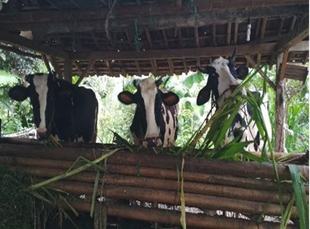EFISIENSI REPRODUKSI SAPI POTONG AKSEPTOR INSEMINASI BUATAN (IB) DI KECAMATAN TIKUNG, KABUPATEN LAMONGAN TAHUN 2015 DAN 2016
Downloads
Badan Pusat Statistik. 2016. Populasi Sapi Potong Menurut Provinsi, 2009-2016a. https://www.bps.go.id/linkTableDina mis/view/id/1016. (21 Maret 2017). Badan Pusat Statistik. 2016. Statistik Daerah Kecamatan Tikung Tahun 2016b. https://lamongankab.bps.go.id/website /pdf_publikasi/Statistik-DaerahKecamatan-Tikung-Tahun-2016.pdf. (20 Maret 2017). Hardijanto, S. Susilowati, T. Hernawati, T. Sardjito, dan T.W. Suprayogi. 2010. Buku Ajar Inseminasi Buatan. Airlangga University Press. Surabaya. Hariadi, M., S. Hardjopranyoto, Wurlina, H.A. Hermadi, B. Utomo, Rimayanti, I.N. Triana, dan H. Ratnani. 2011. Ilmu Kemajiran Pada Ternak. Airlangga University Press. Surabaya. Ismaya. 2014. Bioteknologi Inseminasi Buatan pada Sapi dan Kerbau. Gadjah Mada University Press. Yogyakarta. Jindal, S.K dan M.C. Sharma. 2010. Biotechnology in Animal Health and Production. New India Publishing Agency. Pitam Pura, New Delhi. . Sulaksono, A., S. Suharyati dan E.P. Santoso. 2010. Penampilan Reproduksi (Servise Per Conception, Lama Bunting dan Selang beranak) Kambing Boerawa Di Kecamatan Gedong Tataan dan Kecamatan Gisting. Fakultas Pertanian Universitas Lampung. Lampung. Susilo, T. 2005. Efisiensi Reproduksi Program Inseminasi Buatan Terhadap Sapi Lokal Pada Daerah Lahan Basah dan Kering Di Kabupaten Magelang Propinsi Jawa Tengah [Thesis]. Fakultas Peternakan. Universitas Diponegoro. Sutrisno. 2010. Pembibitan Sapi Potong Melalui Teknologi Inseminasi Buatan (IB) di Kabupaten Pati. Kantor Penelitian dan Pengembangan Pati. Toelihere, M.R. 1977. Inseminasi Buatan pada Ternak. Penerbit Angkasa. Bandung. Utomo, S dan E. Boquifai. 2010. Pengaruh Temperature dan Lama Thawing Terhadap Kualitias Spermatozoa Sapi dalam Penyimpanan Straw Beku. Jurnal Sains Peternakan. 8(1): 22-25.
Ovozoa by Unair is licensed under a Creative Commons Attribution-ShareAlike 4.0 International License.
1. The journal allows the author to hold the copyright of the article without restrictions.
2. The journal allows the author(s) to retain publishing rights without restrictions
3. The legal formal aspect of journal publication accessibility refers to Creative Commons Attribution Share-Alike (CC BY-SA).
4. The Creative Commons Attribution Share-Alike (CC BY-SA) license allows re-distribution and re-use of a licensed work on the conditions that the creator is appropriately credited and that any derivative work is made available under "the same, similar or a compatible license”. Other than the conditions mentioned above, the editorial board is not responsible for copyright violation.




































